南开大学727文学基础考研大纲2019年与2018年对比一览表(文学院)
- 格式:pdf
- 大小:261.05 KB
- 文档页数:3
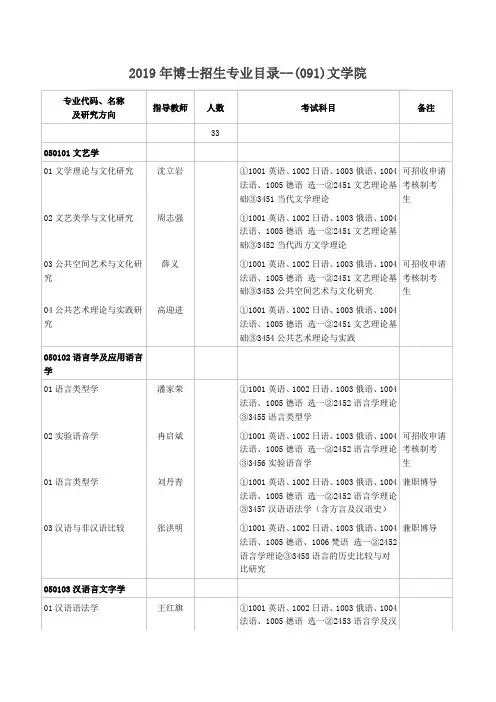
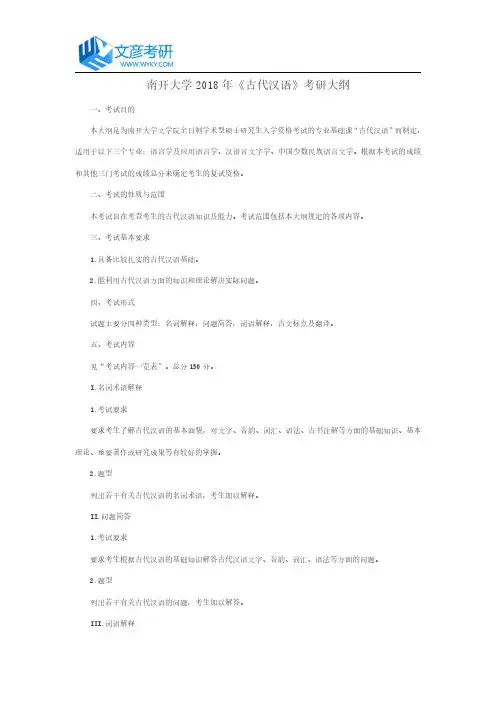
南开大学2018年《古代汉语》考研大纲一、考试目的本大纲是为南开大学文学院全日制学术型硕士研究生入学资格考试的专业基础课“古代汉语”而制定,适用于以下三个专业:语言学及应用语言学、汉语言文字学、中国少数民族语言文学。
根据本考试的成绩和其他三门考试的成绩总分来确定考生的复试资格。
二、考试的性质与范围本考试旨在考查考生的古代汉语知识及能力。
考试范围包括本大纲规定的各项内容。
三、考试基本要求1.具备比较扎实的古代汉语基础。
2.能利用古代汉语方面的知识和理论解决实际问题。
四、考试形式试题主要分四种类型:名词解释,问题简答,词语解释,古文标点及翻译。
五、考试内容见“考试内容一览表”。
总分150分。
I.名词术语解释1.考试要求要求考生了解古代汉语的基本面貌,对文字、音韵、词汇、语法、古书注解等方面的基础知识、基本理论、重要著作或研究成果等有较好的掌握。
2.题型列出若干有关古代汉语的名词术语,考生加以解释。
II.问题简答1.考试要求要求考生根据古代汉语的基础知识解答古代汉语文字、音韵、词汇、语法等方面的问题。
2.题型列出若干有关古代汉语的问题,考生加以解答。
III.词语解释1.考试要求要求考生掌握一定数量的比较常用的古代汉语词汇,能准确地理解语词在具体语境的含义或用法。
2.题型列出若干古代汉语的语句,考生对其中指定的词语加以解释。
Ⅳ.标点及翻译1.考试要求考生应能读懂不太繁难的古文,能比较准确地为古文施加现代标点,并翻译成现代汉语。
2.题型给出一篇(或一段)无标点的古文,考生在答题纸上抄录原文,加上现代标点,翻译成现代汉语。
答题和计分考生用钢笔、签字笔或圆珠笔将答案写在答题纸上。
文章来源:文彦考研。
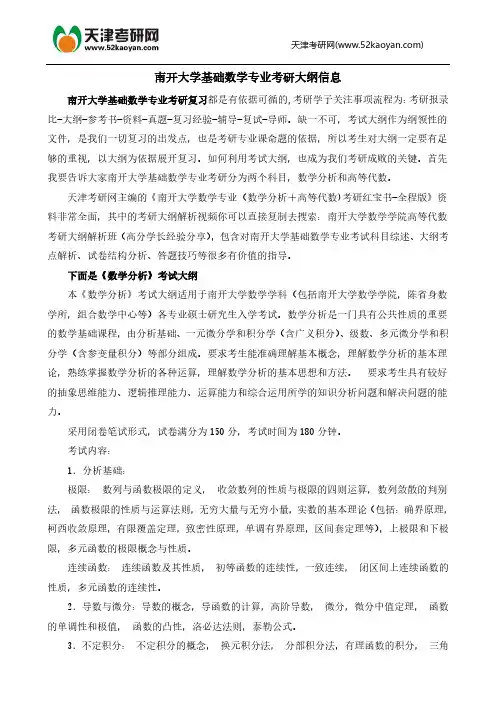
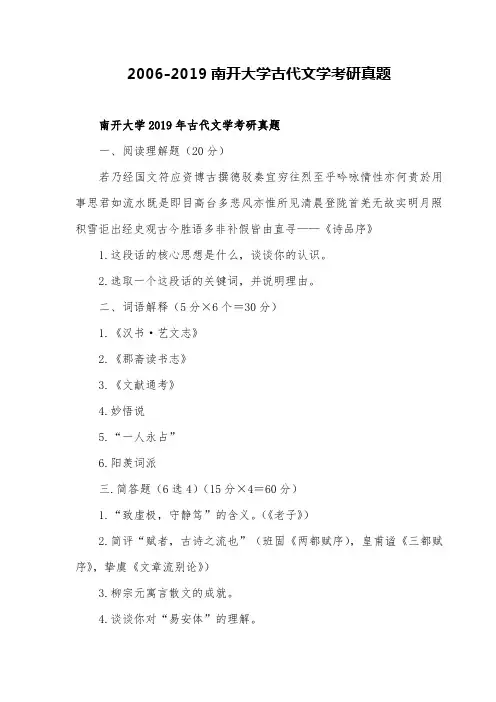
2006-2019南开大学古代文学考研真题南开大学2019年古代文学考研真题一、阅读理解题(20分)若乃经国文符应资博古撰德驳奏宜穷往烈至乎吟咏情性亦何贵於用事思君如流水既是即目高台多悲风亦惟所见清晨登陇首羌无故实明月照积雪讵出经史观古今胜语多非补假皆由直寻——《诗品序》1.这段话的核心思想是什么,谈谈你的认识。
2.选取一个这段话的关键词,并说明理由。
二、词语解释(5分×6个=30分)1.《汉书·艺文志》2.《郡斋读书志》3.《文献通考》4.妙悟说5.“一人永占”6.阳羡词派三.简答题(6选4)(15分×4=60分)1.“致虚极,守静笃”的含义。
(《老子》)2.简评“赋者,古诗之流也”(班固《两都赋序),皇甫谧《三都赋序》,挚虞《文章流别论》)3.柳宗元寓言散文的成就。
4.谈谈你对“易安体”的理解。
5.明代“前七子”的文学成就。
6.以《聊斋志异》的一篇作品为例,分析其艺术手法。
四、论述(4选2)(20分×2=40分)1.《易传》中“立象以尽意,系辞以尽言”的文学思想意义。
2.许学夷《诗源辩体》中一段关于汉魏五言诗的论说,谈谈许氏的观点。
3.元好问的诗歌和诗论的成就4.孔尚任《桃花扇》的思想和艺术成就。
南开大学2018年硕士研究生入学考试试题考试科目:中国古代文学一、阅读下面一段话,回答下面问题(每小题10分,合计20分):江左宫商发越贵于清绮河朔河义贞刚重乎气质气质则理胜其词清绮则文过其意理深者便于时用文华者宜于咏歌此其南北词人得失之大较也若能掇彼清音简兹累句各去所短舍其两长则文质斌斌尽善尽美矣------《隋书.文学传序》1、这段文字要表达的主要思想是什么?2、谈谈你对这段文字的理解。
二、词语解释题(每小题5分,共六小题,合计30分):1、《古文苑》2、《文选》3、《文苑英华》4、苏门四学士5、以诗为词6、《直斋书录解题》三、简答题(在下列各题中,任选四个题目作答,多答不计分。
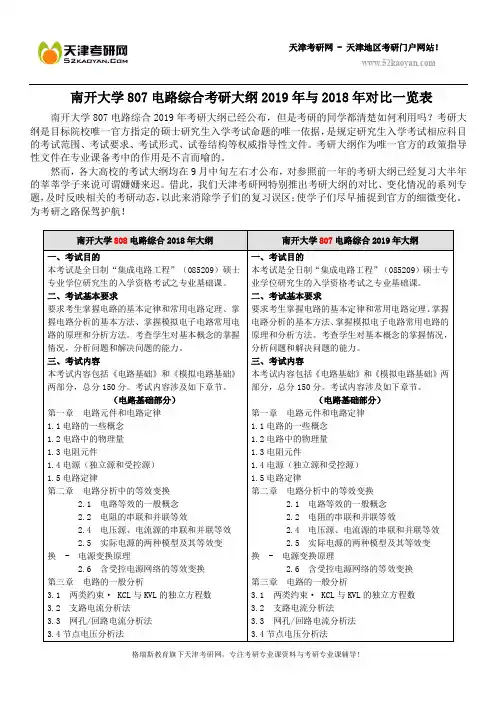
南开大学807电路综合考研大纲2019年与2018年对比一览表
南开大学807电路综合2019年考研大纲已经公布,但是考研的同学都清楚如何利用吗?考研大纲是目标院校唯一官方指定的硕士研究生入学考试命题的唯一依据,是规定研究生入学考试相应科目的考试范围、考试要求、考试形式、试卷结构等权威指导性文件。
考研大纲作为唯一官方的政策指导性文件在专业课备考中的作用是不言而喻的。
然而,各大高校的考试大纲均在9月中旬左右才公布,对参照前一年的考研大纲已经复习大半年的莘莘学子来说可谓姗姗来迟。
借此,我们天津考研网特别推出考研大纲的对比、变化情况的系列专题,及时反映相关的考研动态,以此来消除学子们的复习误区;使学子们尽早捕捉到官方的细微变化。
为考研之路保驾护航!
以上是南开大学807电路综合2019年与2018年考研大纲的对比情况,从对比文件可以看出,南开大学807电路综合的考研大纲没有发生变化。
所以,报考目标院校目标专业的研友们可以安心的按照已定计划去复习备考。
南开大学807电路综合考研资料请到天津考研网官网咨询查看。
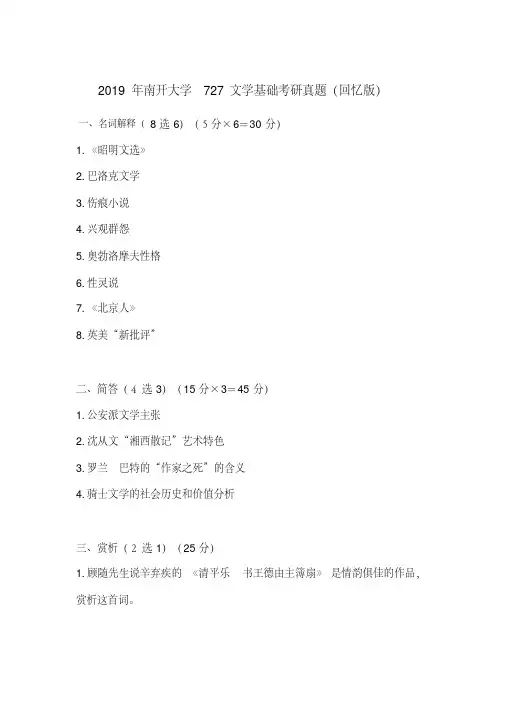
2019年南开大学727文学基础考研真题(回忆版)一、名词解释(8选6)(5分×6=30分)1.《昭明文选》2.巴洛克文学3.伤痕小说4.兴观群怨5.奥勃洛摩夫性格6.性灵说7.《北京人》8.英美“新批评”二、简答(4选3)(15分×3=45分)1.公安派文学主张2.沈从文“湘西散记”艺术特色3.罗兰·巴特的“作家之死”的含义4.骑士文学的社会历史和价值分析三、赏析(2选1)(25分)1.顾随先生说辛弃疾的《清平乐·书王德由主簿扇》是情韵俱佳的作品,赏析这首词。
溪回沙浅。
红杏都开遍。
鸂鶒不知春水暖。
犹傍垂杨春岸。
片帆千里轻船。
行人想见敧眠。
谁似先生高举,一行白鹭青天。
2.闻一多的《死水》这是一沟绝望的死水,清风吹不起半点漪沦。
不如多扔些破铜烂铁,爽性泼你的剩菜残羹。
也许铜的要绿成翡翠,铁罐上绣出几瓣桃花;在让油腻织一层罗绮,霉菌给他蒸出些云霞。
让死水酵成一沟绿酒,漂满了珍珠似的白沫;小珠们笑声变成大珠,又被偷酒的花蚊咬破。
那么一沟绝望的死水,也就夸得上几分鲜明。
如果青蛙耐不住寂寞四、论述(4选2)(25分×2=50分)1.文学经典是永恒的艺术体现还是权力的构建产物,谈谈你的看法。
2.关汉卿的杂剧的分类和艺术成就。
3.文学的雅俗关系一直是争论的交点,从“雅俗”的角度谈谈你对金庸小说和金庸现象的理解。
4.20世纪西方文学中人的困境的描写。
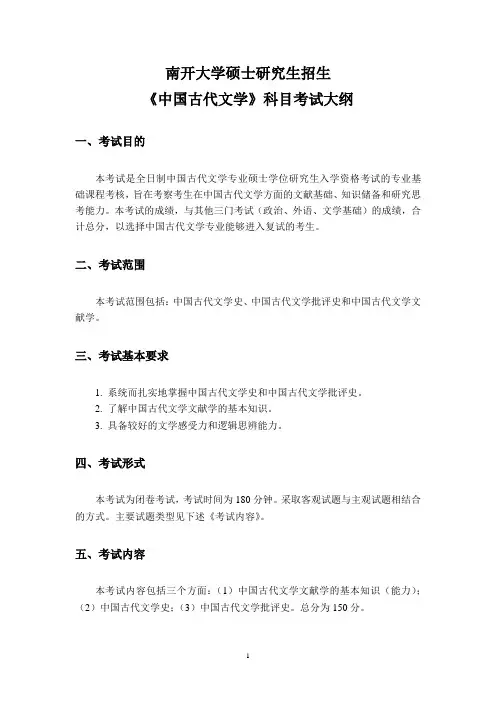
南开大学硕士研究生招生《中国古代文学》科目考试大纲一、考试目的本考试是全日制中国古代文学专业硕士学位研究生入学资格考试的专业基础课程考核,旨在考察考生在中国古代文学方面的文献基础、知识储备和研究思考能力。
本考试的成绩,与其他三门考试(政治、外语、文学基础)的成绩,合计总分,以选择中国古代文学专业能够进入复试的考生。
二、考试范围本考试范围包括:中国古代文学史、中国古代文学批评史和中国古代文学文献学。
三、考试基本要求1. 系统而扎实地掌握中国古代文学史和中国古代文学批评史。
2. 了解中国古代文学文献学的基本知识。
3. 具备较好的文学感受力和逻辑思辨能力。
四、考试形式本考试为闭卷考试,考试时间为180分钟。
采取客观试题与主观试题相结合的方式。
主要试题类型见下述《考试内容》。
五、考试内容本考试内容包括三个方面:(1)中国古代文学文献学的基本知识(能力);(2)中国古代文学史;(3)中国古代文学批评史。
总分为150分。
I. 中国古代文学文献学的基本知识(能力)1. 考试要求要求考生在熟稔文献学一般知识(目录、版本、典藏、校勘、辑佚)的基础上,重点掌握古代文学文献的目录和版本知识;具备古典文献的基本阅读能力。
2. 适用题型(1)给出10部(或少于10部)古代文学常用的文献,要求考生写出其各自的作者(或编者、注者)及其朝代。
(2)给出一段古典文献原文,要求考生阅读并回答问题。
II. 中国古代文学史1. 考试要求要求考生全面、系统、准确地掌握先秦至近代文学的发展演变历程,重点把握历代重要的作家作品、文体演进、文学创作流派、文学创作思潮,以及与文学创作和发展直接相关的社会思想文化。
2. 适用题型(1)词语解释题:给出6个(或少于6个)中国古代文学史的概念、专有名词或成语,要求考生作简要解释。
(2)简答题:给出4个(或少于4个)中国古代文学史的比较具体的问题,要求考生作简要论析。
(3)论述题:给出2个(或1个)中国古代文学史的综合问题,要求考生作比较充分的论述。
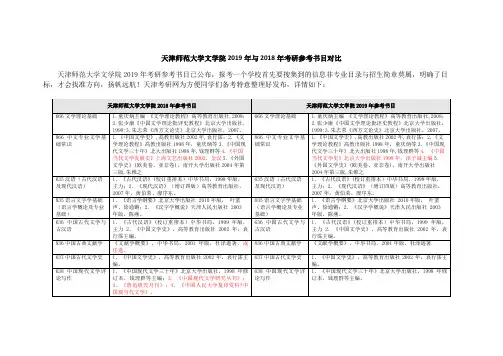
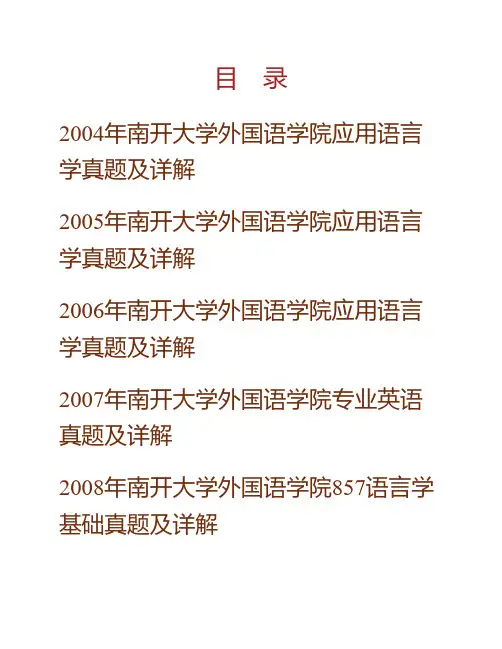
目 录2004年南开大学外国语学院应用语言学真题及详解2005年南开大学外国语学院应用语言学真题及详解2006年南开大学外国语学院应用语言学真题及详解2007年南开大学外国语学院专业英语真题及详解2008年南开大学外国语学院857语言学基础真题及详解2009年南开大学外国语学院857语言学基础真题及详解2010年南开大学外国语学院904语言学基础真题及详解2011年南开大学外国语学院866语言学基础真题及详解2012年南开大学外国语学院883语言学基础真题及详解2004年南开大学外国语学院应用语言学真题及详解考试科目:应用语言学I. Illustrate each of the following terms briefly. (45 points)1. prescriptive linguistics【答案】Prescriptive linguistics: the linguistics that tries to lay down rules for “correct” behaviors. It seeks to tell people how language ought to be used by those who wish to use it.2. Displacement【答案】Displacement: Language can be used to refer to what is present, what is absent, what happens at present, what happened in the past, what will happen in the future or what happens in a far-away place. This property of language enables language users to overcome the barriers caused by time and place. For example, we can talk about Sapir, who is already dead; we can even talk about next week, which is in the future.3.IPA【答案】IPA: the abbreviation of International Phonetic Alphabet, which is devised by the International Phonetic Association in 1888. IPA is a set of symbols which can be used to represent the phones and phonemes of natural languages.4.suprasegmental【答案】Suprasegmental: aspects of speech that involve more than single sound segments. The principle Suprasegmental features are syllable, stress, tone, and intonation.5.blendings【答案】Blending is a process in which two words are blended by joining the initial part of the first word and the final part of the second word, or byjoining the initial parts of the two words. For example, the word “smog” is blended from “smoke” and “fog”.6.denotation【答案】Denotation: the core sense of a word or a phrase that relates it to phenomena in the real world. In the case of linguistic signs, the denotative meaning is what the dictionary attempts to provide. It is the literal meaning of a word, the dictionary meaning, opposite to connotation.7.hyponymy【答案】Hyponymy. It refers to the sense relationship between a more general, more inclusive and a more specific word. The word which is more general in meaning is called the superordinate, and the more specific words are called its hyponyms. For example, the hyponymy relationship could be established between “animal” and “rabbit”.8.stem【答案】A stem is any morpheme or combination of morphemes to which an inflectional affix can be added. For example, “friend-” in friends, and “friendship-” in friendships are both stems. The former shows that a stem can be equivalent to a root, whereas the latter shows that a stem may contain a root and a derivational affix.9.inflectional morpheme【答案】Inflectional morpheme: It is also called inflectional affixes, which attaches to the end of words Inflectional affixes and only add a minute or delicate grammatical meaning to the stem. The plural suffix is a typical example of this kind.10.back-formation【答案】It refers to an abnormal type of word-formation where a shorter word is derived by deleting an imagined affix from a longer form already in the language. For example, from “editor” the word “edit” was generated.11.c-command【答案】C-command: A c-commands B if and only if: 1) A does not dominate B and B does not dominate A; 2) The first branching dominating A also dominates B.12.Sapir-Whorf hypothesis【答案】Sapir-Whorf hypothesis consists of two parts: linguistic determinism and linguistic relativity. Linguistic determinism refers to the notion that a language determines certain nonlinguistic cognitive processes. Different languages offer people different ways of expressing around, they think and speak differently. Linguistic relativity refers to the claim that the cognitive processes that are determined are different for different languages. Thus, speakers of different languages are said to think in different ways. The hypothesis is now interpreted mainly in two different ways: a strong version and a weak one. The strong version believes that the language patterns determine people’s thinking and behavior; the weak one holds that the former influence the later. So far, many researches and experiments conducted provide support to the weak version.13.context of situation【答案】Context of situation: It refers to the linguistic and situational environment in which a word, utterance or text occurs. The meaning of utterances, etc., is determined not only by the literal meaning of the words used but also by the context or situation in which they occur.14.corpus linguistics【答案】Corpus linguistics: an approach to investigating language structure and use through the analysis of large databases to real language examples stored on computer. Issues amenable to corpus linguistics include the meanings of words across registers, the distribution and function of grammatical forms and categories, the investigation of lexico-grammatical associations, and issues in language acquisition and development. 15.CALL【答案】CALL: It is the abbreviation of computer-assisted language learning, which refers to the use of a computer in the teaching or learning of a second or foreign language. In this kind of CALL programs, the computer leads the student through a learning task step-by-step, asking questions to check comprehension. Depending on the student’s response, the computer gives the student further practice or progresses to new material.II. Name each of the following IPA symbols. (10 points)1.[]【答案】voiceless postalveolar fricative2.[j]【答案】palatal approximant3.【答案】glottal plosive4.[w]【答案】bilabial approximant5.[x]【答案】voiceless velar fricative6.[υ]【答案】high back lax rounded vowel7.[æ]【答案】low front lax unrounded vowel8.[p]【答案】voiceless bilabial plosive9.【答案】voiceless aspirated affricate10.[d]【答案】voiced post-alveolar affricateIII. Read each of the following statements carefully and decide whether it is true or false. (10 points)1.Odgen and Richards argue that the relation between a word and a thing it refers to is not direct.【答案】T【解析】本题考查语义三角理论。

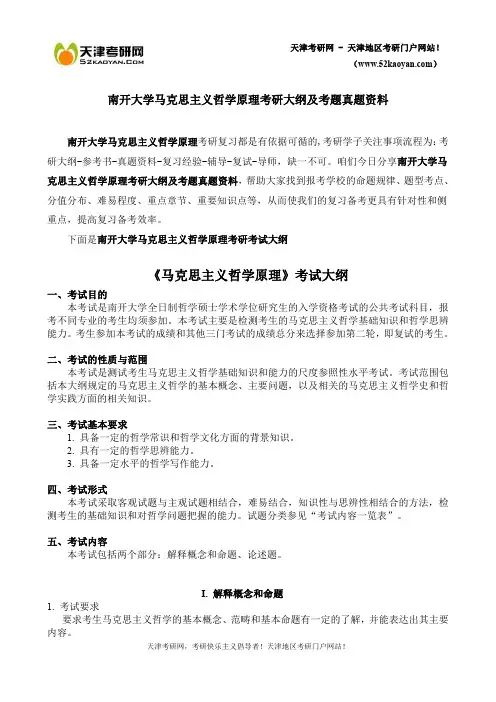
南开大学马克思主义哲学原理考研大纲及考题真题资料南开大学马克思主义哲学原理考研复习都是有依据可循的,考研学子关注事项流程为:考研大纲-参考书-真题资料-复习经验-辅导-复试-导师,缺一不可。
咱们今日分享南开大学马克思主义哲学原理考研大纲及考题真题资料,帮助大家找到报考学校的命题规律、题型考点、分值分布、难易程度、重点章节、重要知识点等,从而使我们的复习备考更具有针对性和侧重点,提高复习备考效率。
下面是南开大学马克思主义哲学原理考研考试大纲《马克思主义哲学原理》考试大纲一、考试目的本考试是南开大学全日制哲学硕士学术学位研究生的入学资格考试的公共考试科目,报考不同专业的考生均须参加。
本考试主要是检测考生的马克思主义哲学基础知识和哲学思辨能力。
考生参加本考试的成绩和其他三门考试的成绩总分来选择参加第二轮,即复试的考生。
二、考试的性质与范围本考试是测试考生马克思主义哲学基础知识和能力的尺度参照性水平考试。
考试范围包括本大纲规定的马克思主义哲学的基本概念、主要问题,以及相关的马克思主义哲学史和哲学实践方面的相关知识。
三、考试基本要求1.具备一定的哲学常识和哲学文化方面的背景知识。
2.具有一定的哲学思辨能力。
3.具备一定水平的哲学写作能力。
四、考试形式本考试采取客观试题与主观试题相结合,难易结合,知识性与思辨性相结合的方法,检测考生的基础知识和对哲学问题把握的能力。
试题分类参见“考试内容一览表”。
五、考试内容本考试包括两个部分:解释概念和命题、论述题。
I.解释概念和命题1.考试要求要求考生马克思主义哲学的基本概念、范畴和基本命题有一定的了解,并能表达出其主要内容。
2.题型要求考生用简洁的语言解释6个马克思主义哲学的基础概念或命题。
II.论述题1.考试要求该部分要求考生掌握马克思主义哲学的诸多主要问题,表达出问题的基本内容,内在逻辑以及与现实生活的关联。
要求语言简洁,逻辑清晰,可以表达出自己对该问题的独特看法。
北师有两个学院招收语言学专业:文学院和汉语文化学院文学院:2019年招生目录:050102语言学及应用语言学9人接收推免生5人左右01普通语言学①101思想政治理论②201英语一③727古代汉语与语言学理论④937古代汉语与现代汉语初试参考书:727 古代汉语及语言学理论古代汉语王宁主编或王力主编北京出版社或高等教育出版社语言学基础理论岑运强北京师范大学出版社2005版语言学纲要(修订版)叶蜚声、徐通锵、王洪君、李娟著北京大学出版社 2010937古代汉语与现代汉语现代汉语周一民或黄伯荣、廖序东北京师范大学出版社或高等教育出版社古代汉语王宁主编或王力主编北京出版社或高等教育出版社语言学理论语言学纲要(修订版)叶蜚声、徐通锵、王洪君、李娟著北京大学出版社2010复试科目:围绕“语言理论”复试,书目不限2018年北师大文学院录取情况解析:共录取总人数80人+免费师范非全50人;文艺学录取5人,分数范围:354-387;课程与教学论录取3人,分数范围:368-375;汉语言文字学录取10人,分数范围:356-385;语言学及应用语言学录取4人,分数范围:348-371;中国古典文献学录取3人,分数范围:341-371;中国古代文学录取8人,分数范围:362-383;比较文学与世界文学录取5人,分数范围:365-404;中国民间文学录取7人,分数范围:336-396;儿童文学录取3人,分数范围:369-379;中国现当代文学:全日制录取12人,分数范围:345-367;非全日制录取20人,分数范围:341-416;学科教学(语文)非全日制录取50人;2018年文学院复试分数线:2019年分数线:复试时间及内容:复试时间:2019年3月19-20日1、复试总分300分,包括专业笔试180分,专业面试100分,外语听力口语20分。
凡笔试成绩低于108分,面试成绩低于60分,复试总分低于180分,不予录取。
2、总成绩=初试成绩+复试成绩3、录取顺序:一般分专业按总成绩顺序录取,凡专业后注明按方向复试的,则分方向按总成绩顺序录取。
南开大学2019年研究生入学考试考试大纲739法学综合(含法理学、宪法、刑法、民法)
一、考试目的
本考试是测试考生的法学基础理论、基本知识掌握的程度,以及运用法学知识分析、解决问题的基本技能。
二、考试的性质与范围
本考试是全日制法学硕士学位研究生的入学资格考试之专业基础考试。
考试范围包括本大纲规定的法学基本概念、规则、理论及其应用。
三、考试基本要求
1. 掌握法理学、宪法、刑法、民法的基础理论和专业知识。
2. 能够运用法理学、宪法、刑法、民法的基础理论、专业知识和方法分析、解决实务问题。
四、考试形式
本考试采取客观试题与主观试题相结合的方法,满分为150分,考试时间为180分钟。
五、考试内容
(一)法理学
1.法的本体:法的概念;法的渊源、形式和效力;法的要素;法律体系;权利和义务;法律行为;法律关系;法律责任;法律程序。
2.法的发展:法律继承;法律移植;法制改革。
3.法的运行:法的运行概述;立法;执法;司法;法律监督;法律方法;
1。
南开大学2023年714文学基础考研真题(回忆版)一、名词解释(共30分,每题5分)
1.诚斋体
2。
花间集
3.“雅舍”散文
4.三一律
5.“罗兰”诗歌
6.《狗儿哥涅槃》
二、简答题(共45分,每题15分)
1.试分析《史记》的叙事艺术。
2.试分析但丁《神曲》的主题。
3.试分析期待视野在文学接受中的作用。
三、赏析(25分)
海子《九月》
目击众神死亡的草原上野花一片远在远方的风比远方更远
我的琴声呜咽泪水全无
我把这远方的远归还草原一个叫木头
一个叫马尾我的琴声呜咽
泪水全无远方只有在死亡中凝聚野花一片
明月如镜高悬草原
映照千年岁月我的琴声呜咽
泪水全无只身打马过草原
四、论述题(共50分,每题25分)
1.试论述《红楼梦》中人物塑造的艺术成就2.试分析19世纪俄罗斯文学中的“多余人”形象。
愿所有年轻人的眼里,都有初升太阳的万丈光芒——谨以此篇致22考研及后来的莘莘学子考研前奏曲- -开篇21考研已慢慢落下帷幕,回想起来,依然意犹未尽,其中有有艰辛,有努力,有回报,有不甘,也有苦中作乐的些许遗憾。
对于南开,我还是有情节的,虽然我也是本二院校,可是学校离南开不远,之前大学时候就去过,在周恩来雕像面前伫立许久,冥冥中的那一刹那,只感觉千百年的光阴在我眼前,一瞬而过。
于是便决定,南开,有生之年,请与我相会。
我本科是汉语言文学专业,也就是大家都所熟知的中文。
我们的这个专业很驳杂,语言,符号,传播,媒体,文学,几乎诗词歌赋,样样不离,因本身更喜欢古诗词里的韵味,常常在唐诗宋词中流连忘返,所以大二就早早定了专业,古代文学。
先说南开大学文学院的专业设置,大概分为,语言学和文学(新闻传播学和外语类没有计算在内),语言学的专业有:语言学及应用语言学,汉语言文字学,中,中国少数民族语言文学等,文学可以分为:文艺学,中国古代文学,中国现当代文学,比较文学与世界文学等。
先说个人,并不是不擅长语言学,只是觉得相对枯燥一些,而且我也问过学长相关,考虑到以后就业问题的话,文学要好于语言学的。
(语言学比较好搞研究,老师说过语言学的博士往往比文学博士要好读一些。
)在这里再说一下中文系读研的毕业去向。
个人家庭条件一般没,所以大学前三年基本上都是出去兼职,大多都是家教的工作,基本上没怎么从家里要过钱,我想表达的是,中文专业的对口出路就是教师,所以一个教师资格证相当重要,哪怕你现在不想当教师,也一定要考一个,你现在多学一样本领,以后就少说一句求别人的话,而且谁也不知道未来会怎样,技多不压身,出去闯社会,多一样看家本领,至少不会让你走太多弯路。
除去教师(貌似中文系大多数男生都不想当老师。
况且我们班只有三个男生。
这个三个姐妹,噢,不,是,这三个同学都没有考研。
)目前就业比较不错的是中文新闻编辑类,之前有学姐考上南京大学的文学专业,毕业做了一名大型杂志社的时尚编辑,待遇不错,还总往欧美跑,各种国际前沿。
南开大学2023年古代文学考研真题(回忆版)
一、阅读理解《文心雕龙·诠赋》
原夫登高之旨,盖睹物兴情。
情以物兴,故义必明雅;物以情观,故词必巧丽。
丽词雅义,符采相胜。
如组织之品朱紫,画绘之著玄黄。
文虽新而有质,色虽糅而有本:此立赋之大体也,然逐末之俦,蔑弃其本;虽读千赋,愈惑体要。
遂使繁华损枝,膏腴害骨;无贵风轨,莫益劝戒。
此扬子所以追悔于雕虫,贻诮于雾縠者也。
(给出的是无标点版)
1、这段话的核心思想
2、你是否同意这个观点
二、名词解释
《世说新语》、元和体、《唐诗三百首》、前七子、《类聚名贤乐府群玉》、《乾嘉诗坛点将录》
三、简答题
1、司马相如赋的特点
2、花间派的创作特点
3、请列举关汉卿的五种剧作
4、简述“诗有别材”的主张
四、论述题
1、钱锺书“唐诗、宋诗,亦非仅朝代之别,乃体格性分之殊。
”请评价这个观点
2、介绍红楼梦索隐派的主要人物和观点。
南开大学727文学基础考研大纲2019年与2018年对比一览表(文学院)
南开大学727文学基础(文学院)2019年考研大纲已经公布,但是考研的同学都清楚如何利用吗?考研大纲是目标院校唯一官方指定的硕士研究生入学考试命题的唯一依据,是规定研究生入学考试相应科目的考试范围、考试要求、考试形式、试卷结构等权威指导性文件。
考研大纲作为唯一官方的政策指导性文件在专业课备考中的作用是不言而喻的。
然而,各大高校的考试大纲均在9月中旬左右才公布,对参照前一年的考研大纲已经复习大半年的莘莘学子来说可谓姗姗来迟。
借此,我们天津考研网特别推出考研大纲的对比、变化情况的系列专题,及时反映相关的考研动态,以此来消除学子们的复习误区;使学子们尽早捕捉到官方的细微变化。
为考研之路保驾护航!
以上是南开大学727文学基础2019年与2018年考研大纲的对比情况,从对比文件可以看出,南开大学727文学基础的考研大纲内容没有发生变化。
所以,报考目标院校目标专业的研友们可以安心的按照已定计划去复习备考。
南开大学727文学基础考研资料请到天津考研网官网咨询查看。